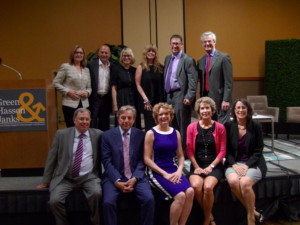
By: Karen Baker (Chief Service Officer, State of California and CaliforniaVolunteers)
Volunteers are a great resource of additional people that can help a nonprofit fulfill its mission — they represent time, talent, and treasure. When I recently spoke at the GHJ 2015 Nonprofit Conference, I described five “secrets” I’ve identified over my career in the nonprofit arena and working alongside such notable leaders as Bill and Hillary Clinton, Maria Shriver, Arnold Schwarzenegger, and Jerry Brown.
Secret #1: Spy on your organization. Just like restaurants use “secret shoppers” to assess the customer experience, you need to assess your volunteer experience. Get your designated secret shopper (a volunteer, of course!) to call in and ask if your organization needs volunteers and take a hard look at the response of the person who answers that call. You will most probably find one of two common blindspots. First, in most cases you will find that the person is not trained or prepared to answer the question. They may ask about the caller’s skills or interests, but if there is not an immediate, direct match, they will end the conversation and leave the potential volunteer frustrated. Second, they may not know how to assess the skill level of the potential volunteer, which means they have almost no chance of discerning where a bank VP would be best utilized versus a 16 year-old high school student.
Secret #2: Understand that today’s volunteers are tomorrow’s donors. Many nonprofits can learn from universities, many of whom have alumni programs that start on the day the student enrolls. Similarly, nonprofits can treat their volunteers as future donors from the day they walk in the door. According to Charity Navigator, $358 billion is given to nonprofits yearly, with 72 percent of that amount coming from individuals. In addition, high net worth donors are most likely to donate to organizations where they or their children volunteer.
Secret #3: Define your plan. It is important to define specific volunteer talents and timeframes that will needed — well in advance. Every volunteer should be matched to a previously defined project on day one. Start with a blank white board and then put down everything you need, no matter what it is. Then leave the white board up so that everyone on the team can see it on a daily basis. I’ve had tremendous success with this approach — a couple of big examples would be getting my organization’s office remodeled for free and having a celebrity television host donate 200 of his custom-made suits for homeless people to go on job interviews.
Secret #4: Create volunteer positions for all your R&D. A nonprofit’s leaders can come up with many amazing ideas, but they rarely have the time to accomplish them all. Asking a qualified volunteer to build that idea out can add a fresh perspective, high energy, and can bond that volunteer with the organization and its goals. An added secret is that it works well to give the volunteer a title that they can be proud of (and potentially put on their resume) like “fellow.”
Secret #5: Be ready to redirect. If a highly qualified person comes to your door, be prepared to help them find the best way to use their skills, even if it is at another organization. Volunteers are looking for a tribe of people that have a similar interest or goal and helping them find it is a success for everyone. Nonprofits that are “service enterprises” stand a much better chance of success. A service enterprise is a nonprofit that is effectively managing 50 or more volunteers at any given time. According to research, only 10-15 percent of nonprofits actually do this, however. To address this issue, CaliforniaVolunteers was among a group of nonprofits that developed a curriculum to help organizations become service enterprises, and more than 250 of them have already gone through the program. You can find more information on the program at the Service Enterprise Initiative website.
...
About Karen Baker Karen serves as Chief Service Officer for CaliforniaVolunteers, the State Service Commission charged with administering the nation’s largest state AmeriCorps portfolio. In addition, CaliforniaVolunteers serves as the lead agency for disaster volunteering and donations management and promotes volunteering and service across California.
She was appointed by Former Governor Schwarzenegger to serve as the first-in-the-nation state cabinet Secretary of Service and Volunteering on February 26, 2008. Prior to this appointment, she served the Schwarzenegger Administration as the executive director of CaliforniaVolunteers. Karen brings to the organization 20 years of innovative leadership in all facets of the service and volunteering sector, including local and national nonprofits and federal agencies.
Previously, Karen served as the managing partner for Valley Vision, a Sacramento-based “action tank” that addresses regional economic, environmental and social issues. She also served as the director of innovation at Share Our Strength, a national anti-hunger nonprofit located in Washington, D.C. Karen served as director for program coordination and special projects for the Corporation for National Service, and was appointed by President Clinton as the deputy director for AmeriCorps*VISTA.
Before serving in Washington D.C., Karen was the executive director of Chrysalis, a nonprofit organization dedicated to helping economically disadvantaged and homeless individuals become self-sufficient through employment opportunities.

